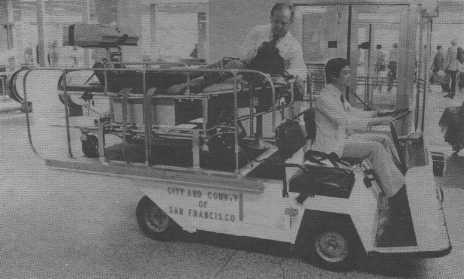California: The Mini-Ambulance
by Randy Cassingham
Every time we go to the airport these days it is jammed. Everyone is in a hurry to buy tickets, catch planes — everyone has a place to go, a person to see. Suddenly, someone drops. A crowd gathers for a quick look before they hurry to their planes. The victim is traveling alone, his doctor is hundreds of miles away. Luckily for this victim he is at San Francisco International Airport. San Francisco International (SFO) is one of the few airports in the United States with a 24-hour medical clinic staffed by MDs.
In the old days Dr. Lawrence A. Smookler, Medical Director of the SFO medical clinic, would run through the large terminals as he rushed about 50 pounds of equipment to the victim’s side. “There has to be a better way,” he thought.
While at a football game one day, Dr. Smookler watched as an injured player was removed from the field in a golf cart. Suddenly he envisioned a large golf cart with a gurney, a drug kit, and a monitor-defibrillator. He could travel around the airport terminals without tiring himself, and he would have a way to transport the victims to his clinic. Smookler took his idea to the Airport Commission to ask for funding. The commission liked the idea so much that Smookler was given $26,000 to develop it. The money was enough for two complete units.
Production was started in an airline hangar. Considerable volunteer labor and materials were provided by the airport and airline employees. The airport in-house Mini-Ambulance was born, the first such unit in the world. It began operation in April, 1975. “It’s a very good thing that we have it,” said Smookler. “Otherwise it would be very difficult to take care of the people who have medical emergencies.”

The Mini-Ambulance responds to calls in the terminal area and will also meet planes that land with a sick patient on board. A local private paramedic ambulance is dispatched to auto accidents and other emergencies outside the terminals. Patients with conditions too serious for the clinic or who need immediate hospitalization are transferred to a local hospital by the private ambulance.
For a traveler who is down in the terminal, a well-rehearsed routine goes into action. A call is made to the airport central dispatcher, whe then alerts the clinic and dispatches an airport police officer to the clinic to pick up the doctor and the Mini-Ambulance. The airport fire department is notified and an EMT/1A crew is dispatched.
In the meantime, if necessary, an airport employee will start CPR. Smookler’s master plan calls for CPR training for at least 10 percent of the airport employees so when an emergency strikes, odds are trained personnel will be nearby. The Mini-Ambulance rushes to the scene at 10-15 mph which, in a crowded terminal, is downright speedy. It travels through hallways, down ramps and sometimes rides in elevators to reach the scene. It usually arrives within five minutes of the call. Pedestrians are chased out of the way with a rotating red beacon and an attention-getting horn.
The Mini-Ambulance is equipped with a detachable stretcher, trauma supplies including spinal immobilization equipment, an EKG monitor and defibrillator, oxygen, an oxygen-powered heart-lung resuscitator (HLR) and a complete IV and drug kit.
A patient being transported in the Mini-Ambulance does not have much privacy because the patient area is not enclosed, for weight and size reasons. While en route back to the clinic, the victim can be treated by the doctor who sits in a chair mounted beside the gurney. If CPR is needed, the on-board HLR can be set up, or an airport employee can ride in with the patient.
The clinic occupies only 1,200 square feet, but it is well packed. There are two exam rooms, a room for minor surgical procedures, an X-ray room, the doctor’s offices and a reception and waiting area. The clinic handles from 35 to 50 patients per day, with five or six being brought in on the Mini-Ambulance. Not only did Smookler bring the Mini-Ambulance to SFO, he was the force that started the clinic itself.
The transient patient population creates some special problems because the patient’s physician and family are often on the other side of the country and have to be called for medical histories. The clinic frequently calls relatives during the middle of the night. Time changes and flight delays often cause problems for people who are on regularly scheduled medication. Some people pack their prescriptions in their bags, so they can’t reach their medication when they need it.
“Frequently people are already in trouble by the time they arrive here,” Smookler said. When they land, Smookler and his Mini-Ambulance are waiting at the gate. The clinic stocks prescription drugs, such as insulin and phenobarbital, so the patients don’t have to try to locate them in their baggage.
According to Dr. Smookler, his Mini-Ambulance idea has been an “outstanding success … it’s ideal for this type of place.”
From Emergency magazine’s “Special Vehicles” issue, November 1981 (I was determined to make them pay me something for my writing after the first freebie!) It also appeared in Grit on August 8, 1982, so I was paid for it again. The concept of write something once, sell it again and again, takes root….
